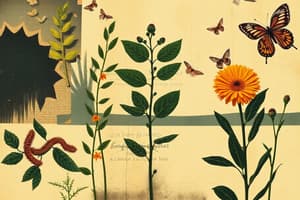Podcast
Questions and Answers
Which of the following are types of autotrophs? (Select all that apply)
Which of the following are types of autotrophs? (Select all that apply)
- Photoautotrophs (correct)
- Detritivores
- Chemoautotrophs (correct)
- Heterotrophs
What is autotrophy?
What is autotrophy?
The process by which organisms produce their own food from inorganic substances.
What is photosynthesis?
What is photosynthesis?
The process by which green plants, algae, and some bacteria convert light energy into chemical energy in the form of glucose.
Where does photosynthesis primarily occur?
Where does photosynthesis primarily occur?
Which of the following is a stage of photosynthesis?
Which of the following is a stage of photosynthesis?
The overall equation for photosynthesis is 6 CO₂ + 6 H₂O + light energy → __________ + 6 O₂.
The overall equation for photosynthesis is 6 CO₂ + 6 H₂O + light energy → __________ + 6 O₂.
What factors affect the rate of photosynthesis? (Select all that apply)
What factors affect the rate of photosynthesis? (Select all that apply)
Why is photosynthesis significant?
Why is photosynthesis significant?
Flashcards are hidden until you start studying
Study Notes
Autotrophy
- Definition: Autotrophy is the process by which organisms produce their own food from inorganic substances.
- Types:
- Photoautotrophs: Use sunlight to synthesize organic compounds. E.g., plants, algae.
- Chemoautotrophs: Obtain energy from chemical reactions involving inorganic molecules. E.g., some bacteria.
- Importance:
- Primary producers in ecosystems.
- Form the base of food chains.
Photosynthesis
- Definition: Photosynthesis is the process by which green plants, algae, and some bacteria convert light energy into chemical energy, storing it in the form of glucose.
- Location: Occurs mainly in the chloroplasts of plant cells, primarily in leaves.
- Overall Equation:
- 6 CO₂ + 6 H₂O + light energy → C₆H₁₂O₆ (glucose) + 6 O₂
- Stages:
- Light-dependent reactions:
- Occur in the thylakoid membranes.
- Convert solar energy into chemical energy (ATP and NADPH).
- Release oxygen as a byproduct.
- Calvin Cycle (Light-independent reactions):
- Occurs in the stroma of chloroplasts.
- Uses ATP and NADPH produced in the light-dependent reactions to fix carbon dioxide into glucose.
- Light-dependent reactions:
- Factors Affecting Photosynthesis:
- Light intensity
- Carbon dioxide concentration
- Temperature
- Significance:
- Provides energy for nearly all ecosystems.
- Produces oxygen essential for aerobic organisms.
Autotrophy
- Definition: Autotrophs are organisms that make their own food using inorganic substances
- Types:
- Photoautotrophs: use sunlight to create food (e.g., plants, algae)
- Chemoautotrophs: use energy from chemical reactions involving inorganic molecules (e.g., some bacteria)
- Importance: Autotrophs are crucial for ecosystems as they are:
- Primary producers: forming the base of food chains
Photosynthesis
- Definition: Photosynthesis is a process where light energy is converted into chemical energy, stored as the sugar glucose
- Location: Occurs in the chloroplasts of plant cells, primarily in leaves
- Overall Equation: 6CO₂ + 6H₂O + light energy --> C₆H₁₂O₆ + 6O₂
- Carbon dioxide and water are used with light energy to produce glucose and oxygen.
- Stages:
- Light-dependent reactions: These occur in the thylakoid membranes, which are stacks of flattened sacs within the chloroplast.
- Solar energy is converted into chemical energy in forms of ATP and NADPH, which are used in the Calvin cycle.
- Oxygen is released as a byproduct
- Calvin Cycle (Light-independent reactions): Occurs in the stroma, the fluid outside the thylakoid membranes.
- Uses ATP and NADPH from the light-dependent reactions to fix carbon dioxide into glucose
- Light-dependent reactions: These occur in the thylakoid membranes, which are stacks of flattened sacs within the chloroplast.
- Factors Affecting Photosynthesis:
- Light intensity: More intense light increases the rate of photosynthesis
- Carbon dioxide concentration: Higher concentration leads to faster rates of photosynthesis
- Temperature: Optimal temperature range allows for efficient photosynthesis, but extreme temperatures inhibit the process
- Significance:
- Provides energy for almost all ecosystems on Earth.
- Produces oxygen, which is vital for aerobic organisms.
Studying That Suits You
Use AI to generate personalized quizzes and flashcards to suit your learning preferences.




